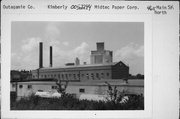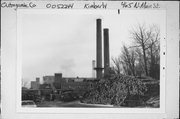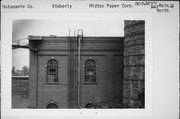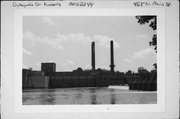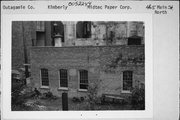Property Record
465 N MAIN ST
Architecture and History Inventory
| Historic Name: | KIMBERLY HYDROELECTRIC |
|---|---|
| Other Name: | Midtec Paper Mill |
| Contributing: | |
| Reference Number: | 52244 |
| Location (Address): | 465 N MAIN ST |
|---|---|
| County: | Outagamie |
| City: | Kimberly |
| Township/Village: | |
| Unincorporated Community: | |
| Town: | |
| Range: | |
| Direction: | |
| Section: | |
| Quarter Section: | |
| Quarter/Quarter Section: |
| Year Built: | |
|---|---|
| Additions: | |
| Survey Date: | 1993 |
| Historic Use: | mill |
| Architectural Style: | Astylistic Utilitarian Building |
| Structural System: | |
| Wall Material: | Brick |
| Architect: | |
| Other Buildings On Site: | |
| Demolished?: | Yes |
| Demolished Date: | 0 |
| National/State Register Listing Name: | Not listed |
|---|---|
| National Register Listing Date: | |
| State Register Listing Date: |
| Additional Information: | A 'site file' exists for this property. It contains additional information such as correspondence, newspaper clippings, or historical information. It is a public record and may be viewed in person at the State Historical Society, Division of Historic Preservation. Extra photo codes are FRV 9/5, 7/11-13. F in the photo codes is short for FCS. A two-story brick rectangle in the older, riverside part of a papermill complex, this utilitarian industrial building has an upstream sidewall divided by piers into four recessed bays. Corbel courses define a frieze in the tile-trimmed parapet that masks the flat roof and is stepped above the two middle bays. Each bay has two stories of cement-silled, metal-famed segmental-arched windows set in round-arched recesses with keystones. Pulpwood piles obscure much of the ground story and any connection between FCS 10/5 and the two enormous brick smokestacks that rise just inland and downstream of it. OAHP INVENTORY (06/1981): The Kimberly Mill was built by Kimberly-Clark's founders in 1889 to manufacture wrapping paper on an 84" cylinder machine. They constructed a ten-ton pulp mill at the same time. The mill entered the newsprint field in 1891 when two fourdrinier machines were added. The cylinder machine was retained in what was called the straw board mill. Here they used to cook straw and burlap bangsand produce enough wrapping paper to wrap the 47" rolls of newsprint which they shipped to the Kansas City Star. This operation was carried on until 1925 when the machine was removed to make room for the present pipe shop. The entire mill burned in 1901. This ended Kimberly as a newsprint plant. When the mill was rebuilt in 1904 it was for the manufacture of book paper. In 1913 the Chlorine Plant was built to ease the problem of bleaching paper. In 1914 the book paper industry was revolutionized when sulphite was introduced to refine ground wood. This process replaced cooking paper and rags. The resulting product called Roto-plate was so good that printers used it exclusively for rotorgravure for many years. In 1926 the first full deckle super calendar was built at Kimberly; this is presently the #2 super. The groundwood slushing system was added in the year 1928; while the addition of a water treatment plant and a change from direct to indirect cooking of chips was in 1929. In 1939 the first 154" super-calendar, went into production. The plant added electricity in 1908. To supplement this power, 3 hydroelectric wheels were added in 1925. |
|---|---|
| Bibliographic References: | (A.) Cooperation, Kimberly-Clark Corporation, 75th Anniversary Issue, Sept.-Oct. 1947, housed in Appleton Public Library. (B.) "Judgements on Kimberly-Clark sale delayed until union talks," Post-Crescent, Appleton, WI, newspaper, 07/09/1976. (C.) "Kimberly-Clark to sell coated paper mill at Kimberly," Post-Crescent, 03/20/1976. |
| Wisconsin Architecture and History Inventory, State Historic Preservation Office, Wisconsin Historical Society, Madison, Wisconsin |

